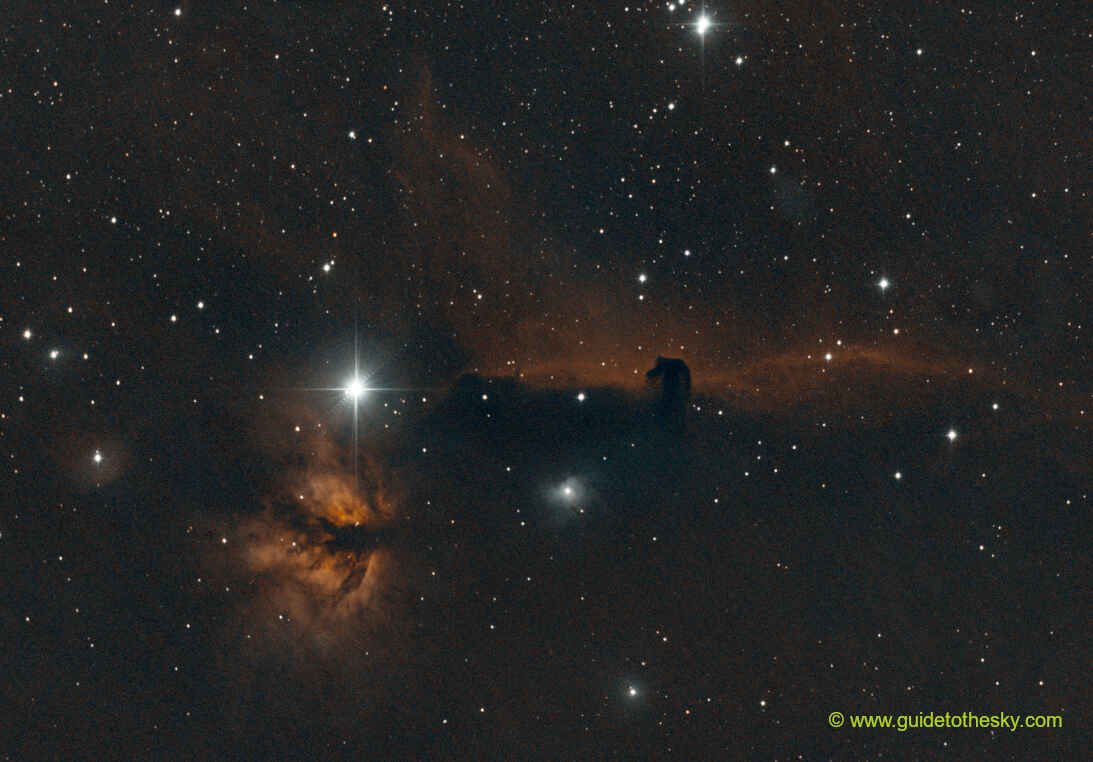NGC 2024 - Orion
La gran Orca, la nebulosa de la llama
NGC2024 pertenece a la constelación de Orion
NGC 2024 es la nebulosa de la Llama.
NGC 2024 es una nebulosa difusa que forma parte del complejo de nebulosas moleculares de Orión, una creadora de mundos, se sabe que su luminosidad no está asociada a ζ-Orionis sino a todo un cúmulo abierto de estrellas contenido en su interior, además se han descubierto discos protoplanetarios dentro de 2024.
Es facil encontrar a NGC 2024 a casi dos grados del ecuador y 15' al Este de ζ-Orionis, es ahí donde podemos encontrar a la espectacular Nebulosa de la Llama o NGC 2024. Muchas otras nebulosas están a menos de un 1º de distancia visual de NGC 2024 como NGC 2024 o la célebre Nebulosa de la Cabeza de Caballo.
NGC 2024 es una nebulosa difusa que forma parte del complejo de nebulosas moleculares de Orión, una creadora de mundos, se sabe que su luminosidad no está asociada a ζ-Orionis sino a todo un cúmulo abierto de estrellas contenido en su interior, además se han descubierto discos protoplanetarios dentro de 2024.
Es facil encontrar a NGC 2024 a casi dos grados del ecuador y 15' al Este de ζ-Orionis, es ahí donde podemos encontrar a la espectacular Nebulosa de la Llama o NGC 2024. Muchas otras nebulosas están a menos de un 1º de distancia visual de NGC 2024 como NGC 2024 o la célebre Nebulosa de la Cabeza de Caballo.
NGC2024 - La gran Orca, la nebulosa de la llama - en la IA
NGC 2024, also known as the Flame Nebula, is a fascinating emission nebula located in the constellation Orion. Here's a breakdown of key information about it:
Key Features:
- Type: Emission Nebula (primarily ionized hydrogen gas)
- Constellation: Orion (near the bright star Alnitak, which is the easternmost star in Orion's Belt)
- Distance: Approximately 900 to 1,500 light-years from Earth (estimates vary)
- Size: Roughly 12 light-years across
- Apparent Magnitude: Relatively faint (around magnitude 10), making it difficult to see with the naked eye
- Appearance: The "Flame" appearance comes from the intense ultraviolet light emitted by the young, massive star Alnitak (Orionis) ionizing the hydrogen gas within the nebula. This ionization causes the hydrogen to glow red. A dark lane of dust in the foreground obscures part of the glowing gas, creating the flame-like structure.
Significance and Scientific Interest:
- Star Formation Region: The Flame Nebula is actively forming stars. Behind the dark dust lane, many young stars are hidden from view in visible light. These stars can be observed using infrared and radio telescopes.
- Influence of Alnitak: Alnitak plays a crucial role in shaping and illuminating the nebula. Its intense radiation is responsible for ionizing the gas and creating the glowing effect.
- Part of the Orion Molecular Cloud Complex: The Flame Nebula is part of a much larger complex of gas and dust in the Orion constellation, which includes other famous nebulae like the Horsehead Nebula and the Orion Nebula (M42). Studying these nebulae together helps astronomers understand the processes of star formation in giant molecular clouds.
How to Observe:
- Telescopes: The Flame Nebula requires a telescope to be seen. A medium-sized telescope (6-8 inches or larger) will reveal its basic shape, but larger telescopes with good filters (especially Hydrogen-alpha filters) are needed to see more detail.
- Location: Find Orion and look for the bright star Alnitak (the easternmost star in Orion's Belt). The Flame Nebula is very close to Alnitak.
- Dark Skies: Dark skies are essential for observing the Flame Nebula. Light pollution will make it very difficult to see.
- Filters: Narrowband filters, particularly Hydrogen-alpha (Hα) filters, are very helpful in blocking out light pollution and enhancing the contrast of the nebula's red glow.
In Summary:
NGC 2024 (the Flame Nebula) is a vibrant and dynamic star-forming region sculpted by the energetic light of Alnitak. Its striking appearance, active star formation, and role in the larger Orion Molecular Cloud Complex make it an important and beautiful object for astronomical study and observation.
Más información sobre NGC 2024 en NASA/IPAC.
Mapa alrededor de NGC 2024
Otros identificadores de NGC2024:
"NGC 2024" ,"[BDB2003] G206.47-16.32","[C2000b] 10" ,


